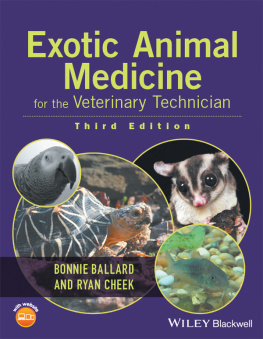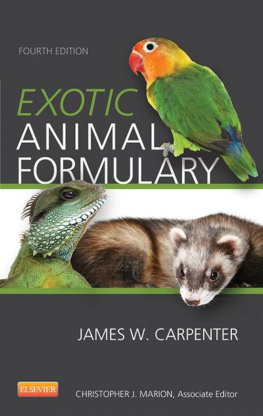vet4dragons, Veterinary Referral & Consultancy, Service for Aquatic & Exotic Animals, Haverfordwest, UK
Scott J. Stahl, DVM, DABVP-Avian
2009, Elsevier Limited. All rights reserved.
), by selecting Customer Support and then Obtaining Permissions.
British Library Cataloguing in Publication Data
A catalogue record for this book is available from the British Library
Library of Congress Cataloging in Publication Data
A catalog record for this book is available from the Library of Congress
Knowledge and best practice in this field are constantly changing. As new research and experience broaden our knowledge, changes in practice, treatment and drug therapy may become necessary or appropriate. Readers are advised to check the most current information provided (i) on procedures featured or (ii) by the manufacturer of each product to be administered, to verify the recommended dose or formula, the method and duration of administration, and contraindications. It is the responsibility of the practitioner, relying on their own experience and knowledge of the patient, to make diagnoses, to determine dosages and the best treatment for each individual patient, and to take all appropriate safety precautions.
To the fullest extent of the law, neither the publisher nor the author assumes any liability for any injury and/or damage.
The Publisher
Printed in China
Dedication
As always, to Lisa
For Elsevier:
Commissioning Editor: Rita Demetriou-Swanwick / Robert Edwards
Development Editor: Louisa Welch
Project Manager: Christine Johnston
Designer: Charles Gray
Illustration Manager: Bruce Hogarth
Illustrator: Debbie Maizels, Zoobotanica
Acknowledgements
Exotic pets are more popular than ever. In some cases they provide companionship, in others they are a fascination and a hobby, and in still others, a cause. I am privileged to be a veterinary surgeon who works solely with exotic species. A great many people have influenced and inspired my professional life in both its course and its content. Many of these are colleagues, students or clients who have become more friends than customers. To single them out would be to put one above the other and I cannot do that, but thank you all.
Foreword
Scott J. Stahl, DVM, DABVP-Avian
http://www.seavs.com, Stahl Exotic Animal Veterinary ServicesFairfax, Virginia, USA
It has been almost 10 years now since I first met Lance Jepson. We were both instructors for a British Small Animal Veterinary Association course in Exotic Animal Medicine in Tewkesbury, Gloucestershire. After a long day of teaching, with each of us tag team lecturing to the delegates, we met in the pub that night for some libation. Even though we had spent the entire day on the subject we were both so excited about the growth and potential within the field of exotic animal medicine, we continued to talk into the wee hours of the night. As we parted, we agreed to continue to focus our clinical work on exclusively exotic pets and we each hoped to one day publish a clinically-relevant book to share our enthusiasm with colleagues.
Lance has done just that with this book Exotic Animal Medicine: A Quick Reference Guide. Writing such a book is truly a monumental task. What the author has provided here is a practical clinicians guide to approaching the exotic pet. The book is user friendly, works nicely as a quick reference, but also provides a review of pertinent clinical information with detailed rule-out lists.
Perhaps the most valuable part of this book is that Lance provides specific information, including diagnostic approaches, clinical techniques, anesthetic protocols and treatment regimens that have worked for him over many years in clinical practice. These days in an atmosphere of data overload with so many internet sources, journals, magazines and other reference books, it is becoming more difficult for veterinarians to wade through materials to find a source of useful clinically-applicable material. Veterinarians, especially practitioners just getting started in the field of exotic animal medicine, will find this book invaluable.
As promised in the pub that night, Lance has devoted his career to working with these non-traditional pets and with this book has found a way to provide something valuable to his colleagues!
Introduction
How to use this book
During their training, veterinarians are taught to apply the same core set of clinical skills and thought processes to the health problems and management of several different domestic species. Often due to time constraints and outmoded perceptions, exotic pets fall off the radar. The practising veterinarian often, therefore, feels at a disadvantage when presented with the more unusual species, yet those same core skills, backed by relevant information, can be applied as easily to a bearded dragon as they can to a bearded collie.
Exotic Animal Medicine: A Quick Reference Guide is designed to aid the veterinary clinician to professionally and quickly deal with a wide array of exotic pets and their problems. It allows the veterinarian to create a diagnostic and treatment plan in a short space of time for a wide range of exotic pets, some of which he or she may not be familiar with.
The approach is hoped to be a practical one, combining both clinical signs and/or an organ system perspective. Thus, a parrot may present with a loss of flight (clinical sign) or have a liver disorder diagnosed on blood sampling (organ system). Where relevant, there is cross-referencing between the different sections.
Lists of differential diagnoses
These provide the clinician with a rapid overview of the likely conditions to be encountered in a given animal group. Where no examples are listed but the heading is still included, these should still be considered even though no examples have been reported in the literature. As an example, neoplasia should occur on most lists of differential diagnoses.
Findings on clinical examination
These list the commonest signs seen within the given group of disorders. Not every clinical sign will be seen in every case, and because of this some may appear contradictory. They are given as an aid to diagnosis. Some diseases may present as a syndrome of typical signs and where this occurs an indication of that disease is given in brackets at the end of the description. I have tried to make these complete and accurate wherever possible, but the huge range of individual and species responses to a multitude of diseases and challenges mean that variations outside those listed are possible.
Investigations
A list of the basic types of investigative procedures is offered to stimulate ideas on how to approach a given case. In some cases, useful general tips are given; in others, normal values (or expected abnormalities) that may be difficult to find in the literature are given where it may aid a diagnosis. In some cases, specific tests for certain diseases, e.g. PCRs, are listed to aid the clinician with the tests that are potentially available (although this may vary from country to country). A basic list of investigations is as follows and, where appropriate, is included in each section to act as a reminder:
Radiography
Routine haematology and biochemistry
Culture and sensitivity



